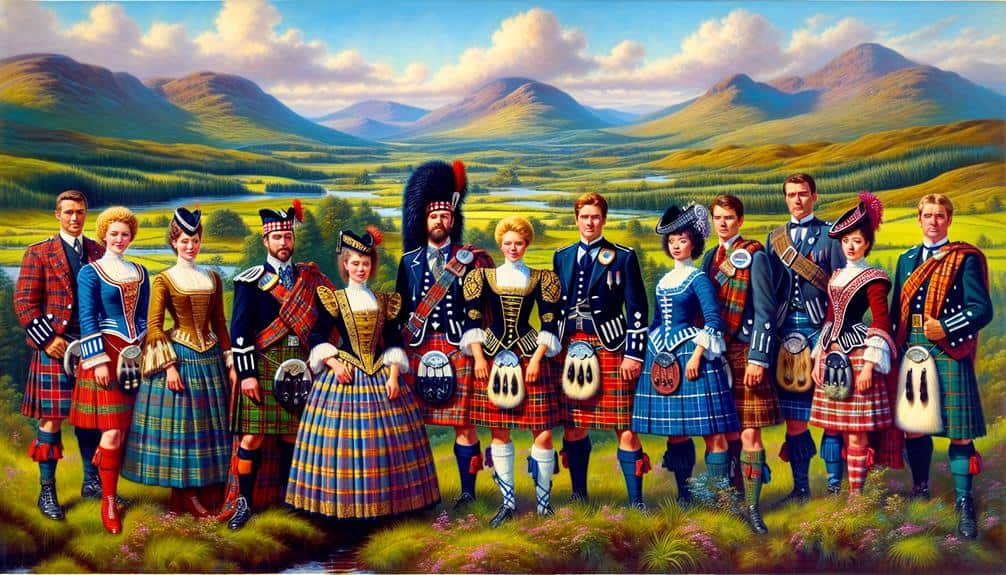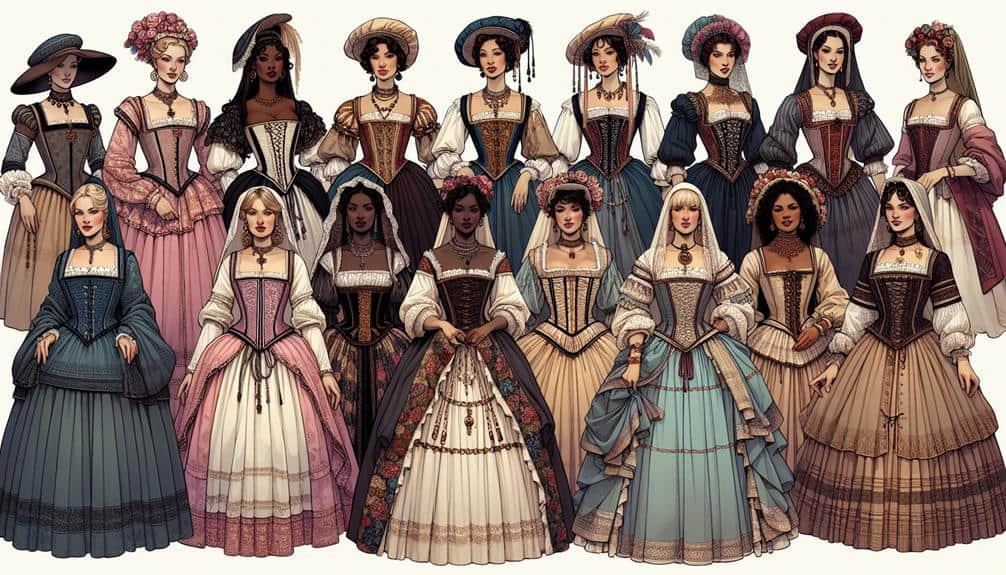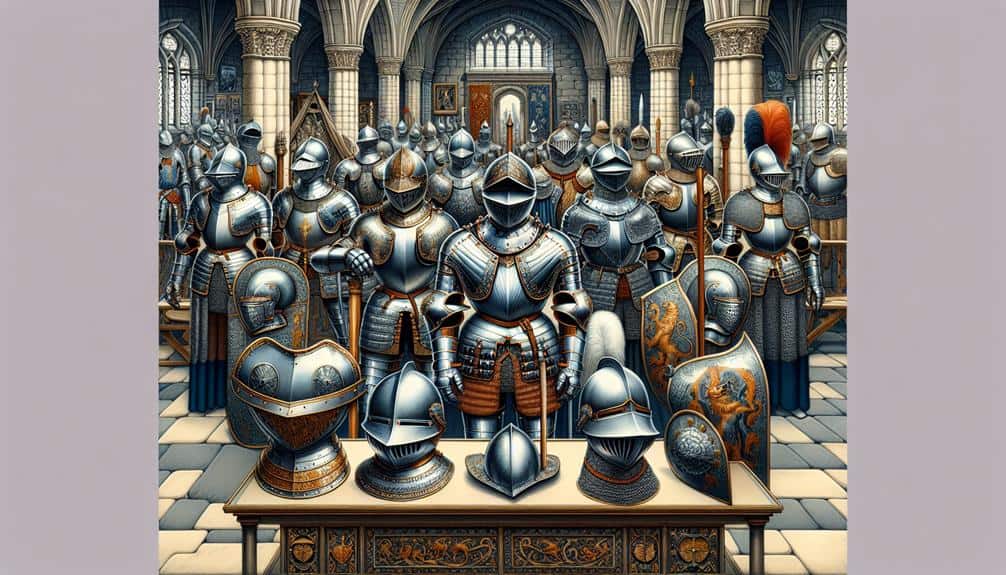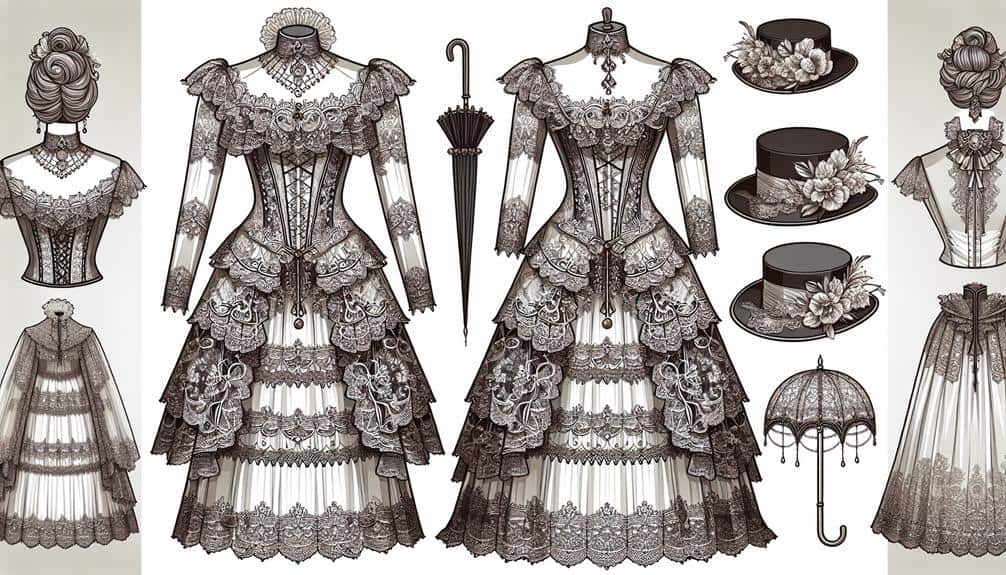Did you know that the Scottish Register of Tartans currently holds over 7,000 unique tartan designs?
The allure of Scottish Highlander kilts and tartans goes beyond mere fashion; it embodies a rich tapestry of history, tradition, and cultural significance that has captivated people worldwide.
From its origins in the rugged Highlands to its modern interpretations in various subcultures, the iconic status of kilts and tartans continues to endure, intriguing both historians and fashion enthusiasts alike.
Key Takeaways
- Scottish kilts and tartans symbolize pride, heritage, and resilience in Scottish culture.
- Kilts were historically a form of rebellion against English rule, representing clans and regions.
- Modern interpretations blend historical accuracy with innovative designs, reflecting a contemporary shift.
- Traditional kilts and tartans celebrate Scottish heritage through symbolic colors, passed down through generations.
Evolution of Scottish Highlander Kilts
The evolution of Scottish Highlander kilts traces back centuries, showcasing a rich tapestry of tradition and cultural significance. The origins of the kilt can be traced to the early 16th century when the feileadh mor, a large piece of tartan cloth, was belted around the waist and draped over the shoulder. Over time, this garment evolved into the tailored kilt we recognize today, with its pleats, tartan patterns, and distinctive style.
The kilt holds immense cultural significance for the Scottish people, symbolizing pride, heritage, and identity. Historically, different tartan patterns were associated with specific regions or clans, allowing individuals to proudly display their affiliations. The kilt also served practical purposes, providing warmth, freedom of movement, and a symbol of solidarity during times of war.
As the kilt evolved from a practical garment to a cultural symbol, its significance deepened within Scottish society. Today, the kilt remains a powerful emblem of Scottish heritage, worn with pride and reverence for tradition.
Symbolism Behind Highland Tartans
Exploring the significance of Highland tartans reveals a colorful tapestry of symbolism woven into the fabric of Scottish heritage and identity.
- Historical Roots: Tartans have deep roots in Scottish history, with each clan developing its unique pattern to distinguish its members from others. These patterns weren't just for aesthetics but were a symbol of pride and belonging, reflecting the wearer's family and regional ties.
- Symbolism of Colors: The colors used in tartans often hold symbolic meanings. For example, red can represent strength and bravery, while green might symbolize the land and fertility. Understanding these color symbolisms adds layers of significance to the tartan patterns.
- Continuation of Tradition: The tradition of wearing tartans has been passed down through generations, evolving from its origins in clan identification to becoming a symbol of Scottish national identity. This continuity connects modern Scots to their rich history and cultural heritage.
- Symbol of Resilience: Tartans also serve as a symbol of resilience, having survived centuries of political and social change. The endurance of tartans as a cultural symbol reflects the enduring spirit of the Scottish people and their commitment to preserving tradition.
Influence of Scottish History on Kilts
Influenced by centuries of turbulent history and cultural evolution, kilts embody a profound connection to Scotland's past and a distinct marker of Scottish identity. The influence of Scottish history on kilts is deeply rooted in the traditions and customs of the Scottish people.
The origins of the kilt can be traced back to the 16th century, evolving from the belted plaid worn by Highlanders as a practical garment for the challenging terrain and unpredictable weather of the Scottish Highlands.
The kilt became more standardized in the 18th century, with the introduction of the iconic tartan patterns that are still prominent today. These tartans weren't just fabric designs but represented specific clans, regions, or institutions, reflecting a sense of identity and allegiance.
Kilts were also historically worn as a symbol of rebellion against English rule, particularly after the failed Jacobite uprisings. This historical context adds layers of significance to the kilt, making it more than just a piece of clothing but a tangible link to Scotland's past and a statement to the enduring traditions of its people.
Popularity of Tartans in Cosplay
With a surge in popularity among cosplayers worldwide, tartans have emerged as a distinctive and sought-after aesthetic choice for dressing up in various character portrayals.
- Historical Accuracy: Many cosplayers meticulously research the specific tartans associated with different clans or regions to guarantee historical accuracy in their costumes. This dedication to authenticity adds depth to the characters they portray.
- Creative Liberties: While some cosplayers stick to traditional tartan patterns, others take creative liberties by blending different tartans or creating their own unique designs. This fusion of historical elements with modern creativity results in visually stunning and original cosplay outfits.
- Cultural Appropriation: It's essential for cosplayers to approach tartan cosplay with sensitivity and respect, avoiding cultural appropriation. By understanding the significance of tartans in Scottish culture and history, cosplayers can pay a respectful homage to this tradition.
- Respectful Homage: When done thoughtfully, incorporating tartans into cosplay can be a way to honor Scottish heritage and celebrate the rich tapestry of traditions associated with these iconic patterns.
Modern Interpretations of Highlander Attire
As cosplay enthusiasts continue to embrace the intricacies of tartans in their costumes, a contemporary shift towards modern interpretations of Highlander attire is evident in the evolving landscape of character portrayal. Contemporary designs play a significant role in this shift, with fashion trends influencing how Highlander attire is reimagined in various media and entertainment platforms. Modern interpretations often incorporate sleeker silhouettes, updated fabric choices, and a fusion of traditional elements with a contemporary twist.
The evolution of Highlander attire reflects a blend of historical accuracy and creative innovation, catering to diverse audiences who appreciate both authenticity and modern aesthetics. Designers and creators are experimenting with bold color combinations, unconventional accessories, and unconventional styling techniques to offer fresh perspectives on traditional Scottish clothing. This modern approach breathes new life into Highlander attire, making it relevant in today's fashion landscape while honoring its rich heritage.
Frequently Asked Questions
Are Kilts Only Worn by Men in Scottish Highlander Culture?
In Scottish Highlander culture, kilts are traditionally associated with men. However, in modern times, gender roles in fashion trends have evolved, allowing both men and women to wear kilts. This shift reflects a broader acceptance and celebration of Scottish heritage.
What Is the Significance of the Different Colors and Patterns in Highland Tartans?
The different colors and patterns in highland tartans hold significant symbolic meanings. Color symbolism plays an important role in representing various aspects of Scottish heritage, such as clan affiliation, social status, and regional identity.
How Do Modern Scottish Highlanders Incorporate Traditional Kilts and Tartans Into Their Everyday Wardrobe?
Incorporating traditional kilts and tartans into your modern wardrobe as a Scottish Highlander involves a stylish fusion of heritage and trend. By skillfully blending classic elements with contemporary pieces, you showcase cultural pride with flair.
Are There Specific Rules or Etiquette Surrounding the Wearing of Kilts and Tartans?
When wearing kilts and tartans, remember the rules and etiquette. These traditions hold cultural significance. Respect the heritage by following guidelines on patterns, occasions, and proper wearing techniques. Embrace the pride of representing Scottish traditions in your attire.
How Has the Perception of Scottish Kilts and Tartans Evolved Over Time in Popular Culture Outside of Scotland?
Over time, the perception of Scottish kilts and tartans in popular culture outside of Scotland has evolved considerably. Cultural influences like movies, fashion trends, and music have shaped how these iconic elements are viewed globally.



